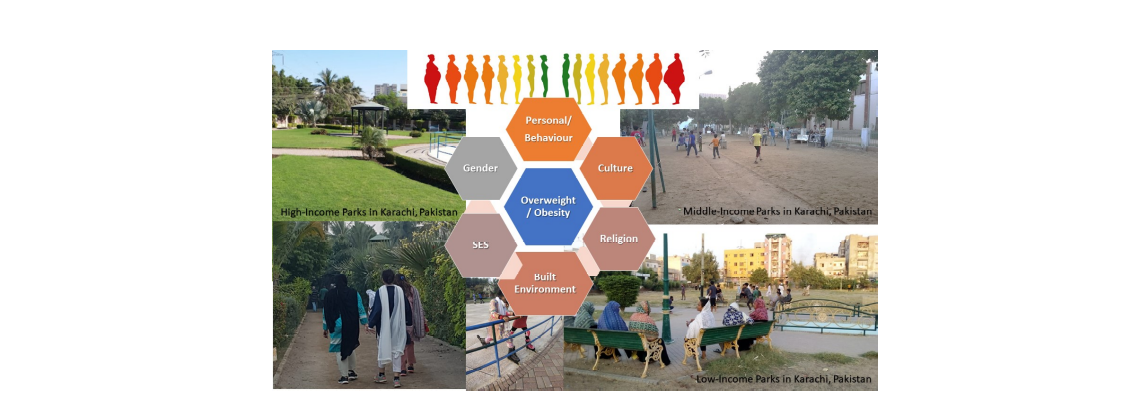In megacity Karachi Pakistan, women and girls’ tendency of being overweight or obese is comparatively higher than men and boys. Sex and socio-economic status-related disparities in built environment contribute negatively to people’s health and especially for women.
For the attention of: Planners, architects, developers, and government officials who contribute to development plans.
The problem: Obesity is a common, serious, and costly disease and varies according to age, education, race, sex, and socio-economic status. Most communities in low-income and middle-income areas suffer in terms of environmental justice and face gender and socio-economic status-related disparities as well as social, cultural, and religious restrictions which deter girls and women from physical activity and sports outside or in parks and playgrounds. These inequalities lead to poor health outcomes, especially for women.
What we did and why: I selected 200-300 random study participants from six neighbourhoods. There were two from each of low-, middle-, and high-income socioeconomic status neighbourhoods. I compared the difference in overweight/obesity rate between males and females.Demographical data was included and male and female study participants (20 years plus) completed a survey questionnaire including various cultural, religious and built environment related questions. The data were analysed through linear regression models as well as descriptive methods to understand the underlying causes of increase in overweight and obesity rate in both genders.
What our study adds: This study tests the assumption whether overweight/obesity rate is higher in males vs females in megacity Karachi, based on available Lancet data for selected Asian countries with comparison on three socioeconomic statuses.
-
This study affirms women’s and girls’ tendency of being overweight or obese is comparatively higher than men and boys in Karachi, Pakistan.
-
This study confirms various built environment, personal, religious, cultural, and socioeconomic factors work differently for both sexes and contribute to increasing BMI of (female) adults in all socio-economic classes.
-
Sex, cultural, and socioeconomic related disparities in built environment contribute negatively to overall people health specifically for women.
Implications for city policy and practice: This case study, by surveying people and neighbourhood environments, informs policymakers, planners, and other related organizations as to how sex, culture, religion, built environment and socio-economic status relates to inequalities faced in predominately low-income and middle-income neighbourhoods. I that health equity could be exacerbated through poor quality of recreational spaces such as parks, playgrounds and other amenities at neighbourhood scale, e.g. walkways and streets.
-
This case study also builds on the fact that neighbourhoods in low-income areas seem to compromise on basic and recreational facilities, with issues including, lack of cleanliness, poor maintenance, and reduced quality and area of open spaces such as parks and playgrounds.
-
This case study proposes that these inequalities result in the absence of facilities in low-income neighbourhood like sports fields, playgrounds, and green spaces along with other secondary spaces such as parking and restrooms which account for low park visitation and physical activity level by both sexes, but especially by women and girls.
This sheds light on a gap between planning practitioners, delivery mechanisms and city municipal authorities responsible for maintenance as well as assigning equitable park distribution in all socio-economic classes.
For further information: The Association of Collegiate Schools of Planning: Faculty Women’s Interest Group.
Full research article: The role of built environment, personal, religious, cultural, and socioeconomic factors in increasing overweight and obesity rate in women vs men: a case study of Karachi, Pakistan by Afsheen Sadaf




